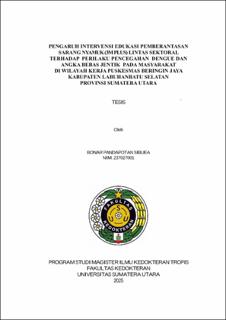Pengaruh Intervensi Edukasi Pemberantasan Sarang Nyamuk (3M Plus) Lintas Sektoral terhadap Perilaku Pencegahan Dengue dan Angka Bebas Jentik pada Masyarakat di Wilayah Kerja Puskesmas Beringin Jaya Kabupaten Labuhanbatu Selatan Provinsi Sumatera Utara
The effect of Cross-Sectoral Mosquito Nest Eradication Education Intervention (3M Plus) on Dengue Prevention Behavior and Larvae-Free Rate in the Community in the Working Area of Beringin Jaya Health Center South Labuhanbatu Regency North Sumatra Province

Date
2025Author
Sibuea, Bonar Pandapotan
Advisor(s)
Amelia, Rina
Ritarwan, Kiking
Metadata
Show full item recordAbstract
The Beringin Jaya Health Center in South Labuhanbatu Regency has experienced an increase in Dengue Hemorrhagic Fever (DHF) cases in 2022 and 2024. Control efforts through mosquito nesting eradication (PSN) with a 3M Plus approach in Torgamba District have not been optimal, caused by low inter-sector coordination and a lack of understanding among the community. This study aims to evaluate the impact of 3M Plus educational intervention involving cross-sector collaboration (Sub-district Head, Village Head, Youth Organization, Health Center, and Jumantik Cadres) on changes in DHF prevention behavior and the free larvae index (ABJ) in the working area of the Beringin Jaya Health Center The research design used is quasi-experimental with a one-group pretest-posttest approach, which measures behavioral variables (knowledge, attitudes, and actions) and the number of free mosquito larvae prevention before and after the intervention. The population in this study is all households in Beringin Jaya Village (917 households) and the sample size is 100 households. The intervention was conducted in Beringin Jaya Village, which had not previously received the PSN program or the ABJ examination. The research lasted for 10 weeks (November 2024 – January 2025). The results of the study indicate that cross-sectoral educational intervention significantly improved community knowledge about dengue prevention, from 45% to 64% (p-value= 0.013). The variables of attitudes and preventive actions have shown an increase; however, this increase is not statistically significant, with p values of 0.643 and 0.417, respectively. Additionally, the educational intervention successfully increased the percentage of houses free of mosquito larvae significantly, from 52% to 100% after the intervention (p-value = 0.0001). Future research is recommended to develop a sustainable community-based mosquito breeding eradication program, with enhanced intensity and duration of interventions, as well as stronger social support and community participation. The program also needs to be tailored to local culture through training and outreach. Further studies should use a stronger design and a broader population coverage to evaluate the impact on changes in attitudes and actions more significantly.
